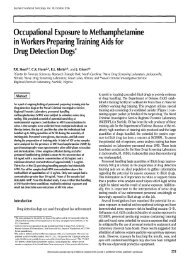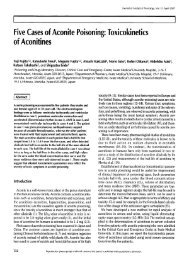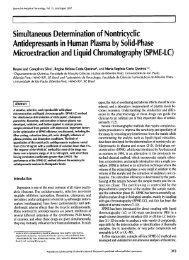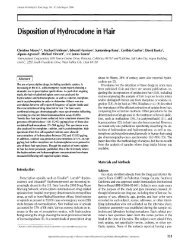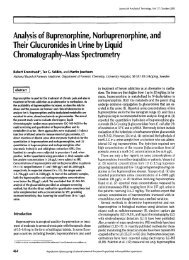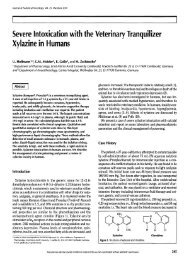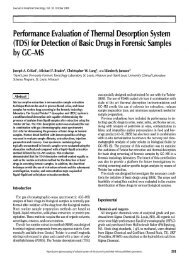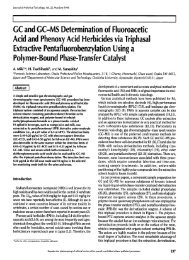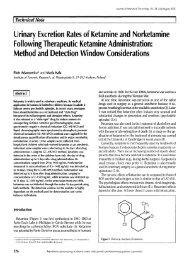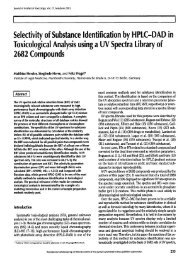A Fatality Related to the Veterinary Anesthetic Telazol - Journal of ...
A Fatality Related to the Veterinary Anesthetic Telazol - Journal of ...
A Fatality Related to the Veterinary Anesthetic Telazol - Journal of ...
You also want an ePaper? Increase the reach of your titles
YUMPU automatically turns print PDFs into web optimized ePapers that Google loves.
<strong>Journal</strong> <strong>of</strong> Analytical Toxicology, Vol. 23, Oc<strong>to</strong>ber 1999<br />
preparation were <strong>the</strong> same. The methods differ only in <strong>the</strong>ir<br />
respective column washes and elution solvents. Zolazepam<br />
showed a good response at <strong>the</strong> lowest calibration level, so <strong>the</strong><br />
differences in column wash and elution solvent did not appear <strong>to</strong><br />
be significant.<br />
Limit <strong>of</strong> detection, limit <strong>of</strong> quantitation, and linearity studies<br />
were not done. The calibration curves were linear with coeffi-<br />
cients <strong>of</strong> correlation (r 2) <strong>of</strong> 1.00 and 0.999 for tiletamine and<br />
zolazepam, respectively. The samples were run at dilutions that<br />
fell within <strong>the</strong> upper and lower calibra<strong>to</strong>rs. The sole exception<br />
was <strong>the</strong> liver zolazepam results.<br />
Postmortem blood, urine, and liver concentrations <strong>of</strong> tile-<br />
tamine, zolazepam, and ketamine are listed in Table I. Data<br />
regarding <strong>to</strong>xic human dosages <strong>of</strong> <strong>Telazol</strong> are nonexistent.<br />
Although <strong>the</strong>re is a preponderance <strong>of</strong> veterinary data regarding<br />
dosages required for chemical restraint and surgical anes<strong>the</strong>sia<br />
<strong>of</strong> various animal species, it is difficult <strong>to</strong> correlate <strong>the</strong>se data <strong>to</strong><br />
humans. Among <strong>the</strong> nonhuman primates most closely related <strong>to</strong><br />
humans, chimpanzee, orangutan, and gorilla, dosages required<br />
for chemical restraint were 3.63 mg/kg, 2.72 mg/kg, and 1.35<br />
mg/kg, respectively. (7) According <strong>to</strong> an article by Eads (7), larger<br />
species <strong>of</strong> primates required smaller doses <strong>of</strong> <strong>Telazol</strong> on a weight<br />
basis <strong>to</strong> produce equivalent results.<br />
Tiletamine belongs <strong>to</strong> <strong>the</strong> same class <strong>of</strong> drugs as ketamine and<br />
phencyclidine. In most respects <strong>the</strong> pharmacokinetics <strong>of</strong> <strong>the</strong>se<br />
drugs are <strong>the</strong> same. In terms <strong>of</strong> potency, tiletamine is between<br />
ketamine and phencyclidine with ketamine being <strong>the</strong> weakest<br />
and phencyclidine <strong>the</strong> most potent. (3) The usual intravenous<br />
dose <strong>of</strong> ketamine required for induction <strong>of</strong> anes<strong>the</strong>sia ranges<br />
from 1 <strong>to</strong> 4.5 mg/kg. (8) A dose <strong>of</strong> 2.5 mg/kg resulted in an<br />
average plasma concentration <strong>of</strong> I IJg/mL after 12 rain, which fell<br />
<strong>to</strong> 0.5 IJg/mL after 30 rain. (9) Phencyclidine in<strong>to</strong>xication is<br />
associated with blood levels <strong>of</strong> 0.007-0.240 IJg/mL. (10) The<br />
usual intravenous dose <strong>of</strong> PCP was 1-3 rag. (11) Toxic concen-<br />
trations <strong>of</strong> phencyclidine range from 0.3 <strong>to</strong> 25 ~g/mL in <strong>the</strong><br />
plasma. (8) The deceased had 1000 mg <strong>of</strong> tiletamine available <strong>to</strong><br />
him, which would result in a dose <strong>of</strong> 9.6 mg/kg if taken all at<br />
once. A dose <strong>of</strong> 8.25 mg/kg was fatal <strong>to</strong> a gorilla after 5 h with<br />
death due <strong>to</strong> respira<strong>to</strong>ry depression. (7) The blood concentra-<br />
tions <strong>of</strong> tiletamine and zolazepam suggest that it is probable <strong>the</strong><br />
decedent did not take <strong>the</strong> full dose available at one time.<br />
The deceased also <strong>to</strong>ok ketamine. Although <strong>the</strong> postmortem<br />
blood concentration <strong>of</strong> ketamine was low, 37 ng/mL, ketamine<br />
and tiletamine are <strong>the</strong> same class <strong>of</strong> compound, and at least an<br />
additive effect can be assumed.<br />
Assessing <strong>the</strong> role <strong>of</strong> zolazepam as a causative agent in this<br />
death is much more difficult. According <strong>to</strong> an article by Lin et al.<br />
(3), zolazepam was <strong>the</strong> least likely <strong>to</strong> cause depression when<br />
compared with chlordiazepoxide and diazepam, which is why it<br />
was chosen in <strong>the</strong> development <strong>of</strong> <strong>Telazol</strong>. Chlordiazepoxide and<br />
diazepam are <strong>the</strong> two most commonly used benzodiazepines in<br />
veterinary medicine. The postmortem blood concentration <strong>of</strong><br />
zolazepam was 1.71 I~g/mL. It is very possible that <strong>the</strong> zolazepam<br />
played a role in enhancing <strong>the</strong> respira<strong>to</strong>ry depression induced by<br />
<strong>the</strong> tiletamine and ketamine; however, it is not possible <strong>to</strong><br />
describe <strong>the</strong> extent <strong>of</strong> that enhancement.<br />
The tremendous difference in <strong>the</strong> blood concentrations <strong>of</strong> <strong>the</strong><br />
two drugs at first glance appears <strong>to</strong> be difficult <strong>to</strong> explain consid-<br />
ering that <strong>Telazol</strong> is equal parts <strong>of</strong> tiletamine and zolazepam. The<br />
most likely explanation for <strong>the</strong> disparity in blood concentrations<br />
<strong>of</strong> tiletamine and zolazepam would be differences in <strong>the</strong> distri-<br />
bution, metabolism, and elimination <strong>of</strong> <strong>the</strong>se two compounds.<br />
The cause <strong>of</strong> death in this case was ruled an acute mixed drug<br />
in<strong>to</strong>xication <strong>of</strong> tiletamine, zolazepam, and ketamine, and <strong>the</strong><br />
manner <strong>of</strong> death was ruled unclassified.<br />
References<br />
1. <strong>Veterinary</strong> Pharmaceutical and Biologicals 1997/1998, 10th ed.<br />
<strong>Veterinary</strong> Medicine Publishing Group, Lenexa, KS 1997,<br />
pp 747-748.<br />
2. R.P. Wilson, I.S. Zagon, D.R. Larach, and M.C. Lang. Cardiovascular<br />
and respira<strong>to</strong>ry effects <strong>of</strong> tiletamine-zolazepam. Pharmacol.<br />
Biochem. Behav. 44(1): 1-8 (1993).<br />
3. H.C. Lin, I.C. Thurmon, G.J. Benson, and W.J. Tranquilli. Tealazol--<br />
a review <strong>of</strong> its pharmacology and use in veterinary medicine. J. Vet.<br />
PharmacoL Ther. 16(4): 383-418 (1993).<br />
4. M.R. Caltet, N.A. Caulkett, S.C. Polischwik, and M.A. Ramsay.<br />
Reversible immobilization <strong>of</strong> free ranging polar bears with mede<strong>to</strong>-<br />
midine-zolazepam-tiletamine and atipamezole. J. Wild Dis. 33(3):<br />
611-617 (1997).<br />
5. Mercklndex, 11th ed. Merck & Co., Inc., Rahway, NJ, 1989.<br />
6. United Chemical Technologies, Inc. Clean Screen | Extraction<br />
Columns Applications Manual, Revision 691070, Bris<strong>to</strong>l, PA.<br />
7. E.E Eads. Tilazol ((:1-744): a new agent for chemical restraint and<br />
anes<strong>the</strong>sia in non-human primates. Vet. Med. Small Anita. Clin.<br />
71(5): 648-652 (1976).<br />
8. R.C. Baselt and R.H. Cravey. Disposition <strong>of</strong> Toxic Drugs and<br />
Chemicals in Man, 4th ed. Chemical Toxicology Institute, Foster<br />
City, CA, 1995.<br />
9. J. Weiber, R. Gugler, J.H. Hengstmann, and H.J. Dengler.<br />
Pharmacokinetics <strong>of</strong> ketamine in man. Anaes<strong>the</strong>sia 24:260--263<br />
(1975).<br />
10. D.S. Pearce. Detection and quantitation <strong>of</strong> PCP in blood by use <strong>of</strong><br />
2H s PCP and selective ion moni<strong>to</strong>ring applied <strong>to</strong> non-fatal cases <strong>of</strong><br />
PCP in<strong>to</strong>xication. Clin. Chem. 22:1623-1626 (1976).<br />
11. G.D. Lundberg, R.C. Gupta, and S.H. Mon<strong>to</strong>gemy. PCP: patterns<br />
seen in street drug analysis. Clin. ToxicoL 9:503-511 (1976).<br />
Manuscript received March 1, 1999;<br />
revision received May 26, 1999.<br />
555



